Transportation Infrastructure, Population Mobility, and Public Health
Abstract
1. Introduction
2. Model Setup
2.1. Individual Decision
2.2. Production
2.3. Public Health
2.4. Government
3. Theoretical Analysis
3.1. The Cross-Sector Population Flow
3.2. Transportation Infrastructure, Population Flow, and Public Health
3.2.1. The Long-Term Driving Factors of Transportation Infrastructure on Flow
3.2.2. The Effect of Infrastructure on Health through Population Flow
4. Empirical Analysis
4.1. Model Specification and Variables
4.2. The Case of Infectious Diseases
4.3. Further Discussion
5. Conclusions
Author Contributions
Funding
Institutional Review Board Statement
Informed Consent Statement
Data Availability Statement
Conflicts of Interest
References
- Donaldson, D. Railroads of the Raj: Estimating the impact of Transportation Infrastructure. Am. Econ. Rev. 2018, 108, 899–934. [Google Scholar] [CrossRef]
- Fan, F.; Zhang, X.Y.; Wang, X.L. Are there political cycles hidden inside collaborative innovation efficiency? An empirical study based on Chinese cities. Sci. Public Policy 2022, 45, 101093005. [Google Scholar] [CrossRef]
- Banerjee, A.; Duflo, E.; Qian, N. On the Road: Access to Transportation Infrastructure and Economic Growth in China. J. Dev. Econ. 2020, 145, 102442. [Google Scholar] [CrossRef]
- Lin, Y. Travel costs and urban specialization patterns: Evidence from China’s high speed railways system. J. Urban Econ. 2017, 98, 98–123. [Google Scholar] [CrossRef]
- Glaeser, E.L. Urbanization and Its discontents, NBER Working Paper 26839. East. Econ. J. 2020, 46, 191–218. [Google Scholar] [CrossRef]
- Fan, F.; Dai, S.Z.; Yang, B. Urban density, directed technological change, and carbon intensity: An empirical study based on Chinese cities. Technol. Soc. 2022, 11, 102151. [Google Scholar] [CrossRef]
- Fan, F.; Dai, S.Z.; Zhang, K.K. Innovation agglomeration and urban hierarchy: Evidence from Chinese cities. Appl. Econ. 2021, 53, 6300–6318. [Google Scholar] [CrossRef]
- Fang, Y.; Zhang, F.; Zhou, C.; Chen, M. Governance Capability of the Public Health System-A Comparative Analysis of the Control of COVID-19 in the Different Provinces of China. Int. J. Environ. Res. Public Health 2021, 18, 4210. [Google Scholar] [CrossRef] [PubMed]
- Wang, X.L.; Wang, L. The spatiotemporal evolution of COVID-19 in China and its impact on urban economic resilience. China Econ. Rev. 2022, 74, 101806. [Google Scholar] [CrossRef] [PubMed]
- Emran, M.S.; Hou, Z. Access to Markets and Rural Poverty: Evidence from Household Consumption in China. Rev. Econ. Stat. 2013, 95, 682–697. [Google Scholar] [CrossRef]
- Agénor, P.R. Health and infrastructure in a model of endogenous growth. J. Macroecon. 2008, 30, 1407–1422. [Google Scholar] [CrossRef]
- Gupta, M.R.; Barman, T.R. Health, infrastructure, environment and endogenous growth. J. Macroecon. 2010, 32, 657–673. [Google Scholar] [CrossRef]
- Wagstaff, A.; Claeson, M. The Millennium Development Goals for Health: Rising to the Challenges. World Bank Publ. 2004, 83, 876–877. [Google Scholar]
- Zhang, F.; Peng, H.; Sun, X.; Song, T. Influence of Tourism Economy on Air Quality—An Empirical Analysis Based on Panel Data of 102 Cities in China. Int. J. Environ. Res. Public Health 2022, 19, 4393. [Google Scholar] [CrossRef] [PubMed]
- Yoo, D. Height and death in the Antebellum United States: A view through the lens of geographically weighted regression. Econ. Hum. Biol. 2012, 10, 43–53. [Google Scholar] [CrossRef] [PubMed]
- Scrimshaw, N. The Changing Body: Health, nutrition, and human development in the Western World since 1700. Food Nutr. Bull. 2011, 32, 318–320. [Google Scholar] [CrossRef]
- He, G.; Xie, Y.; Zhang, B. Expressways, GDP, and the environment: The case of China. J. Dev. Econ. 2020, 145, 102485. [Google Scholar] [CrossRef]
- Zimran, A. Transportation and Health in the Antebellum United States, 1820–1847. J. Econ. Hist. 2020, 80, 670–709. [Google Scholar] [CrossRef]
- Pautrel, X. Pollution, Private Investment in Healthcare, and Environmental Policy. Scand. J. Econ. 2012, 114, 334–357. [Google Scholar] [CrossRef]
- Grossman, M. On the Concept of Health Capital and the Demand for Health. J. Polit. Econ. 1972, 80, 223–255. [Google Scholar] [CrossRef]

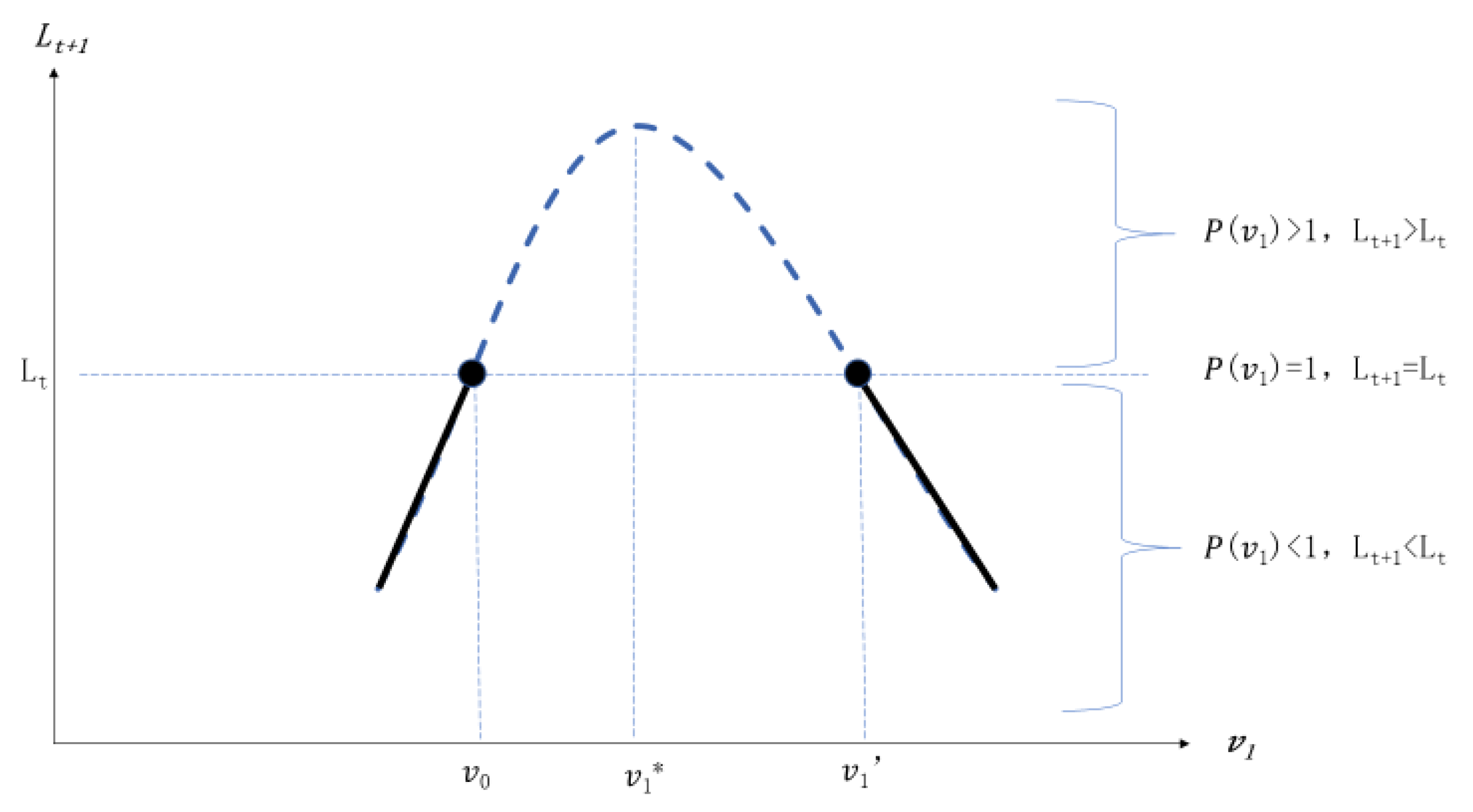
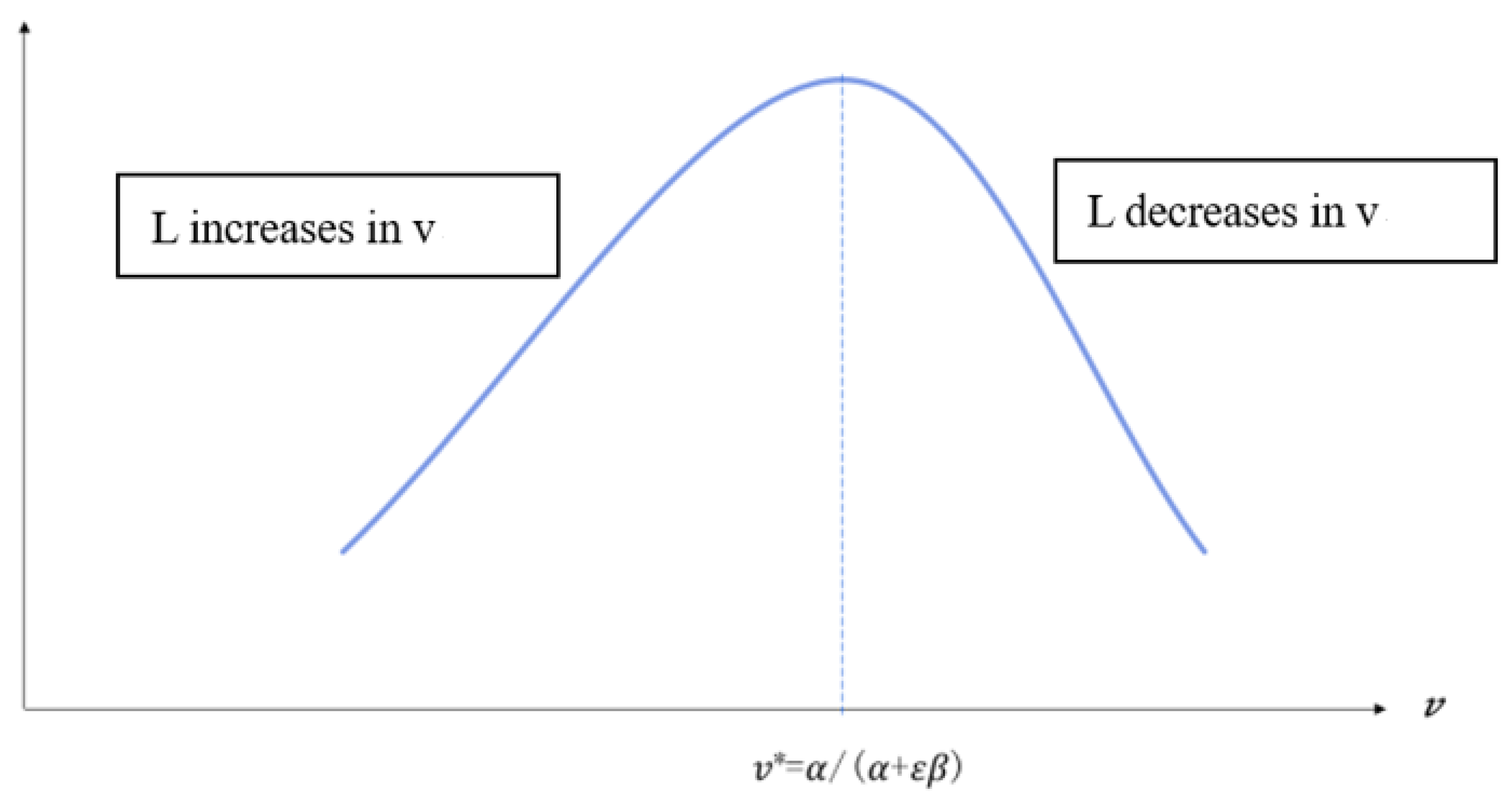
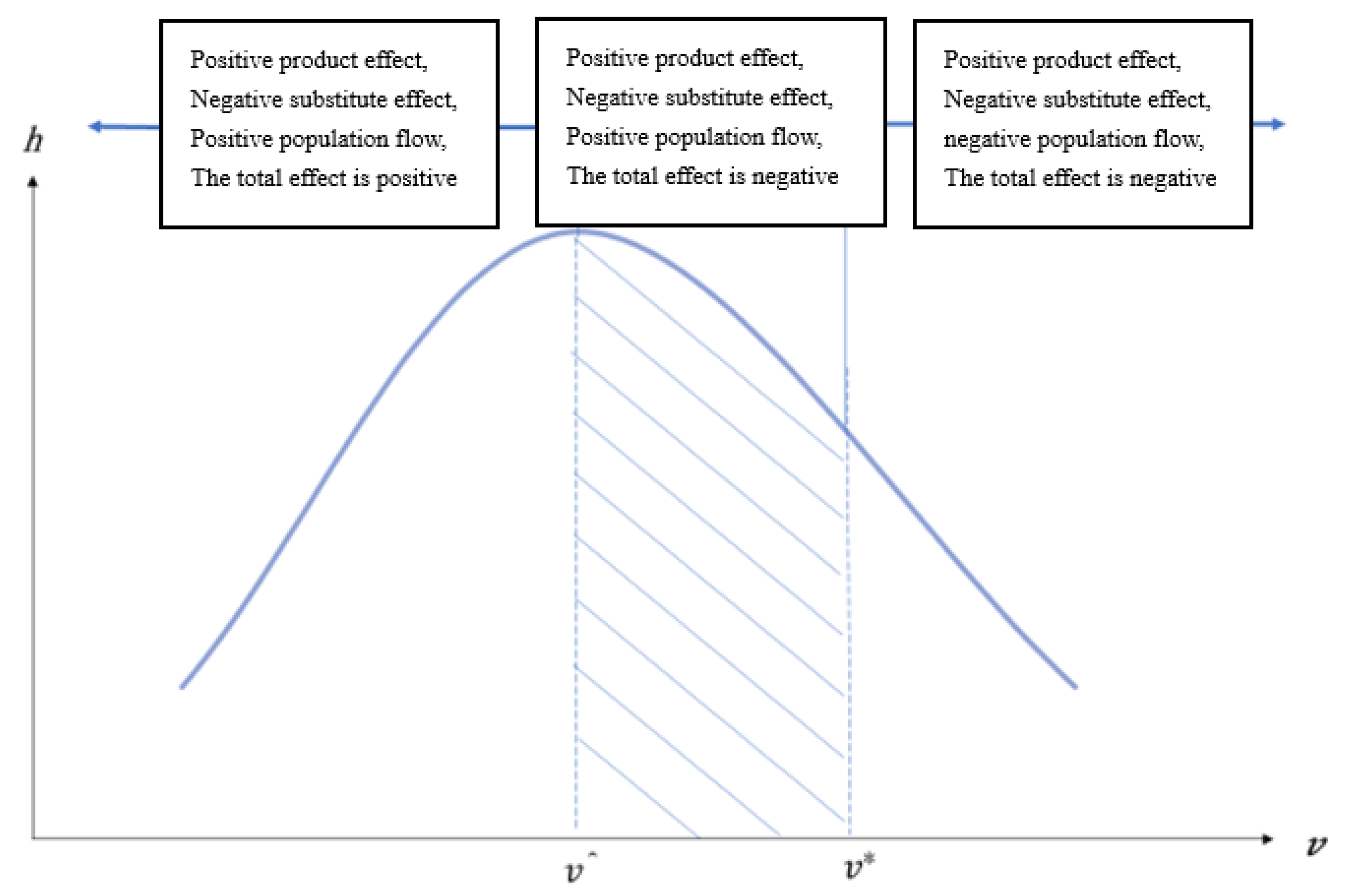
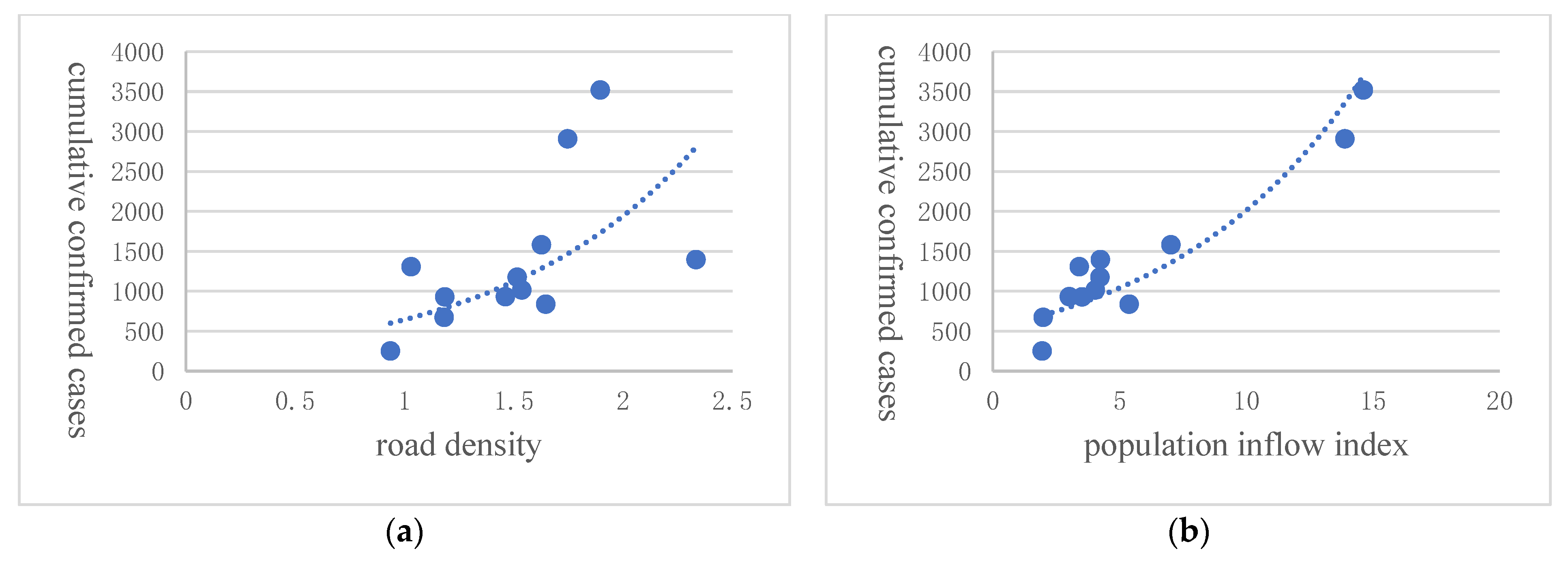
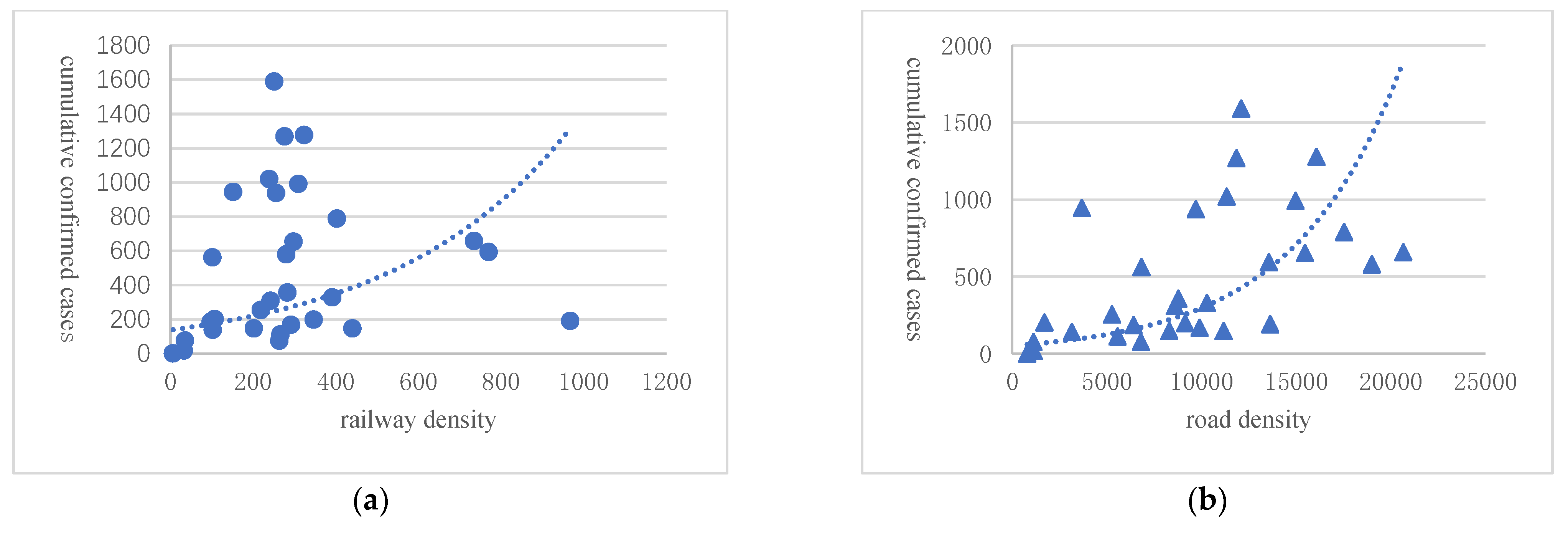
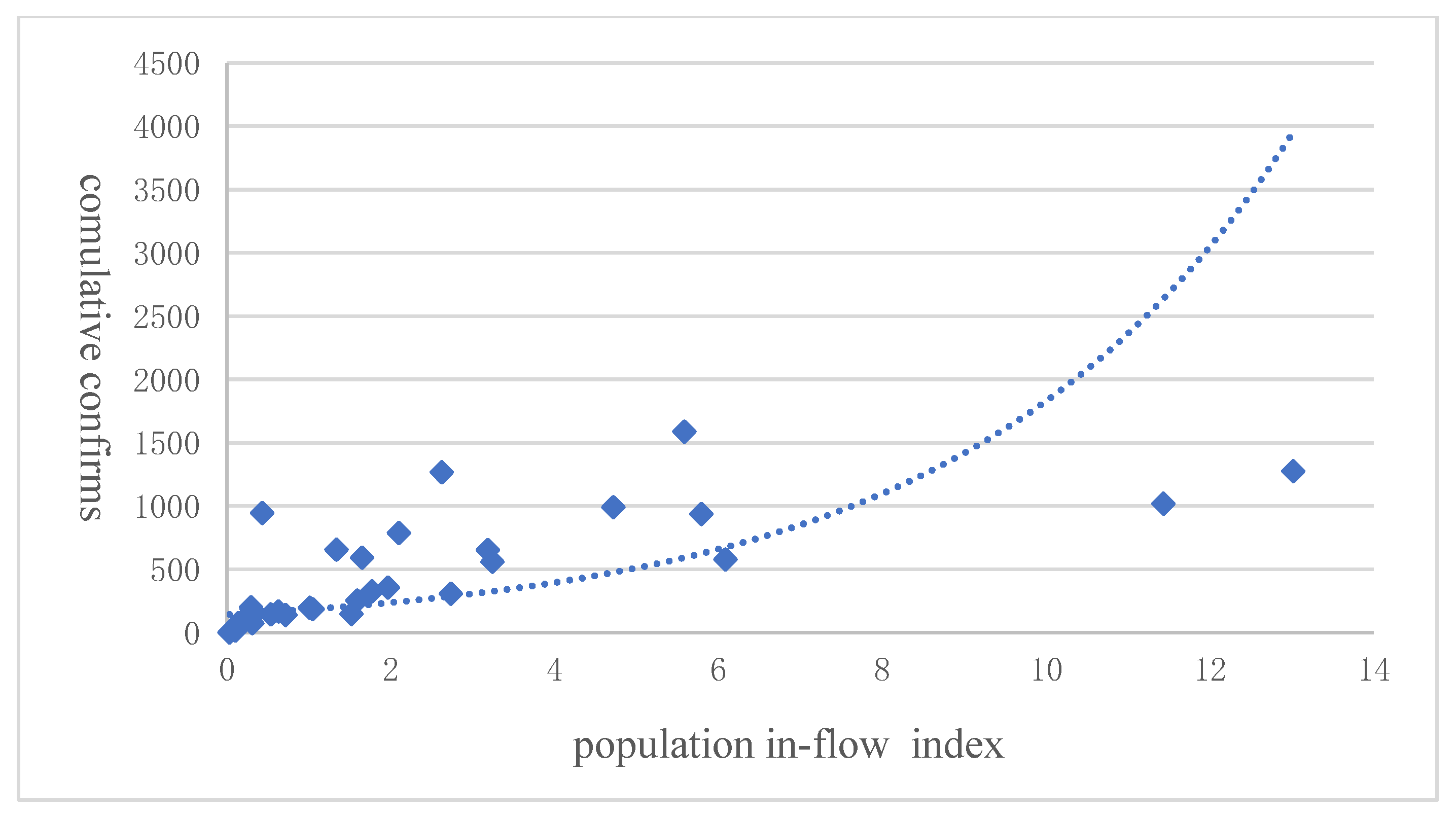
| Variables | Definition and Interpretations | Mean | Std.Err | Min | Max |
|---|---|---|---|---|---|
| crfb | Reported morbidity rates of class A and B Infectious (1/100,000) | 264.38 | 101.59 | 91.24 | 738.19 |
| death | Mortality rate (%) | 6.13 | 0.82 | 4.14 | 11.85 |
| railway | Length of railways/area of province | 192.78 | 168.29 | 8.06 | 875.81 |
| highway | Length of highways/area of province | 6108.16 | 4495.83 | 192.52 | 20,809.02 |
| mob | Permanent Residents-registered population | 17.26 | 441.71 | −1736.99 | 1958.11 |
| popd | Permanent Residents/area of province | 419.19 | 579.99 | 6.88 | 3825.90 |
| soot | Volume of Industrial soot(dust) emission | 32.01 | 23.705 | 1.30 | 145.07 |
| green | Green areas per capita | 12.01 | 9.54 | 1.59 | 57.57 |
| gdp | GDP per capita | 24,580.35 | 21,494.2 | 2215 | 108,000 |
| pubh | Per capita Expenditure for medical and public health | 284.79 | 311.72 | 15.06 | 1706.68 |
| Dependent Variable: Incidence of Infectious Disease | Mortality Rate | ||||
|---|---|---|---|---|---|
| FE(1) | FE(2) | FE(3) | FE(4) | FE(5) | |
| lnrailway | −0.098 (0.369) | 3.699 ** (0.013) | 5.276 *** (0.001) | −2.856 ** (0.038) | |
| lnrailway^2 | −0.128 *** (0.000) | 0.296 *** (0.000) | |||
| lnhighway | −1.512 (0.409) | ||||
| lnhighway^2 | −0.026 (0.193) | ||||
| lnmob | 2.830 (0.000) | 2.913 *** (0.000) | 2.602 *** (0.000) | 1.202 (0.381) | −0.159 (0.869) |
| lnrailway * lnmob | −0.506 ** (0.011) | −0.555 *** (0.005) | 0.011 (0.949) | ||
| lnhighway * lnmob | 0.302 (0.192) | ||||
| lnpopd | 2.628 *** (0.001) | −0.696 (0.644) | −1.258 (0.397) | 4.274 *** (0.004) | −0.429 (0.167) |
| lnpopd * lnmob | −0.443 *** (0.000) | 0.092 (0.647) | −0.644 *** (0.001) | ||
| lnsoot | −0.056 (0.167) | −0.061 (0.126) | −0.078 * (0.051) | −0.010 (0.804) | 0.073 (0.248) |
| lngreen | 0.002 (0.978) | −0.013 (0.836) | 0.013 (0.825) | −0.037 (0.527) | 0.129 (0.151) |
| L_lngdp | 0.379 *** (0.000) | 0.384 *** (0.000) | 0.330 *** (0.001) | 0.127 (0.228) | −0.794 *** (0.000) |
| L_lnhcare | −0.167 *** (0.005) | −0.167 *** (0.005) | −0.138 ** (0.019) | −0.133 ** (0.022) | 0.406 *** (0.000) |
| observations | 406 | 406 | 406 | 406 | 522 |
| 0.092 | 0.108 | 0.142 | 0.156 | 0.147 | |
| F statistic | 4.70 (0.000) | 4.97 (0.000) | 6.05 (0.000) | 6.76 (0.000) | 9.28 (0.000) |
| Dependent Variable: Incidence of Infectious Disease | ||||||
|---|---|---|---|---|---|---|
| Panel 1: The Density of Public Infrastructure | Panel 2: The Population Flow | |||||
| High FE(1) | Middle FE(2) | Low FE(3) | Net in Flow FE(4) | Balanced FE(5) | Net Out Flow FE(6) | |
| lnrailway | 7.942 *** (0.000) | 6.023 (0.114) | 11.802 *** (0.000) | 7.545 *** (0.000) | −12.943 (0.205) | −2.412 (0.307) |
| lnmob | 2.758 ** (0.046) | 3.913 (0.121) | 5.899 *** (0.000) | 6.390 *** (0.000) | −8.325 (0.224) | 2.886 *** (0.001) |
| lnrailway^2 | −0.422 *** (0.004) | 0.069 (0.690) | −0.365 *** (0.000) | −0.122 ** (0.019) | −0.092 (0.207) | 0.555 *** (0.002) |
| lnrailway * lnmob | −0.477 ** (0.047) | −0.904 * (0.061) | −1.232 *** (0.000) | −0.845 *** (0.000) | 1.793 (0.179) | −0.466 *** (0.002) |
| Control variables | √ | √ | √ | √ | √ | √ |
| observations | 140 | 126 | 140 | 140 | 126 | 140 |
| 0.285 | 0.203 | 0.320 | 0.449 | 0.236 | 0.288 | |
| F statistic | 5.34 (0.000) | 3.05 (0.003) | 6.32 (0.000) | 10.97 (0.000) | 3.71 (0.000) | 5.42 (0.000) |
Disclaimer/Publisher’s Note: The statements, opinions and data contained in all publications are solely those of the individual author(s) and contributor(s) and not of MDPI and/or the editor(s). MDPI and/or the editor(s) disclaim responsibility for any injury to people or property resulting from any ideas, methods, instructions or products referred to in the content. |
© 2022 by the authors. Licensee MDPI, Basel, Switzerland. This article is an open access article distributed under the terms and conditions of the Creative Commons Attribution (CC BY) license (https://creativecommons.org/licenses/by/4.0/).
Share and Cite
Zhang, F.; Song, T.; Cheng, X.; Li, T.; Yang, Z. Transportation Infrastructure, Population Mobility, and Public Health. Int. J. Environ. Res. Public Health 2023, 20, 751. https://doi.org/10.3390/ijerph20010751
Zhang F, Song T, Cheng X, Li T, Yang Z. Transportation Infrastructure, Population Mobility, and Public Health. International Journal of Environmental Research and Public Health. 2023; 20(1):751. https://doi.org/10.3390/ijerph20010751
Chicago/Turabian StyleZhang, Fen, Tianyi Song, Xiang Cheng, Tianhao Li, and Ziming Yang. 2023. "Transportation Infrastructure, Population Mobility, and Public Health" International Journal of Environmental Research and Public Health 20, no. 1: 751. https://doi.org/10.3390/ijerph20010751
APA StyleZhang, F., Song, T., Cheng, X., Li, T., & Yang, Z. (2023). Transportation Infrastructure, Population Mobility, and Public Health. International Journal of Environmental Research and Public Health, 20(1), 751. https://doi.org/10.3390/ijerph20010751






